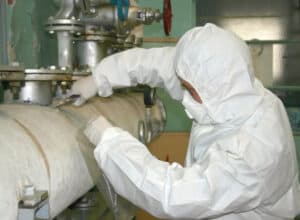What Colour is Asbestos Insulation?
 Prior to 2000, asbestos was widely used in the construction industry, which means it’s present in a significant number of buildings that were erected before this time. However, asbestos comes in many different forms, including white asbestos, brown asbestos, and blue asbestos.
Prior to 2000, asbestos was widely used in the construction industry, which means it’s present in a significant number of buildings that were erected before this time. However, asbestos comes in many different forms, including white asbestos, brown asbestos, and blue asbestos.
Both white and brown asbestos were commonly used as an insulation material within residential homes and commercial buildings, so you might want to look out for these coloured fibres if you suspect asbestos is present in your property. Although blue asbestos was most commonly used for insulating steam engines, it was also used in some commercial products, such as spray-on insulation or pipe lagging. Due to this, it’s possible that a commercial or residential property constructed before 1985 will also contain blue asbestos as a form of insulation.
Can You Identify Asbestos Visually?
 In its natural form, asbestos is fairly easy to recognise during a visual inspection. However, it was heavily processed before being used in the construction industry. When used as insulation, for example, asbestos may have been mixed with other materials and formed into circular pipe shapes for lagging or into insulation boards. In addition to this, materials may have been painted in order to enhance the exterior of a property, which can lead to further confusion.
In its natural form, asbestos is fairly easy to recognise during a visual inspection. However, it was heavily processed before being used in the construction industry. When used as insulation, for example, asbestos may have been mixed with other materials and formed into circular pipe shapes for lagging or into insulation boards. In addition to this, materials may have been painted in order to enhance the exterior of a property, which can lead to further confusion.
As a result, you shouldn’t rely on a visual examination in order to determine whether or not asbestos is present in a building. Instead, you should assume that any structure built before 2000 contains some form of asbestos.
How Are Buildings Checked for Asbestos?
An experienced surveyor or builder may be able to advise whether asbestos is present from a visual inspection, as it’s very recognisable in some forms. However, suspected materials must be sent away for analysis before the presence of asbestos can be officially confirmed. This is done by using personal protective equipment (PPE) and specialist tools to remove a sample of the material and transporting it securely to a laboratory, where testing can be conducted safely.
Should Asbestos Be Removed from Buildings?
Asbestos becomes most dangerous when it is disturbed, as this releases asbestos fibres into the air which can be inhaled. Due to this, property owners aren’t required to have asbestos removed from their buildings. If you do choose to have asbestos removed from your home or a commercial building, however, it’s essential that this work is undertaken by certified professionals.
